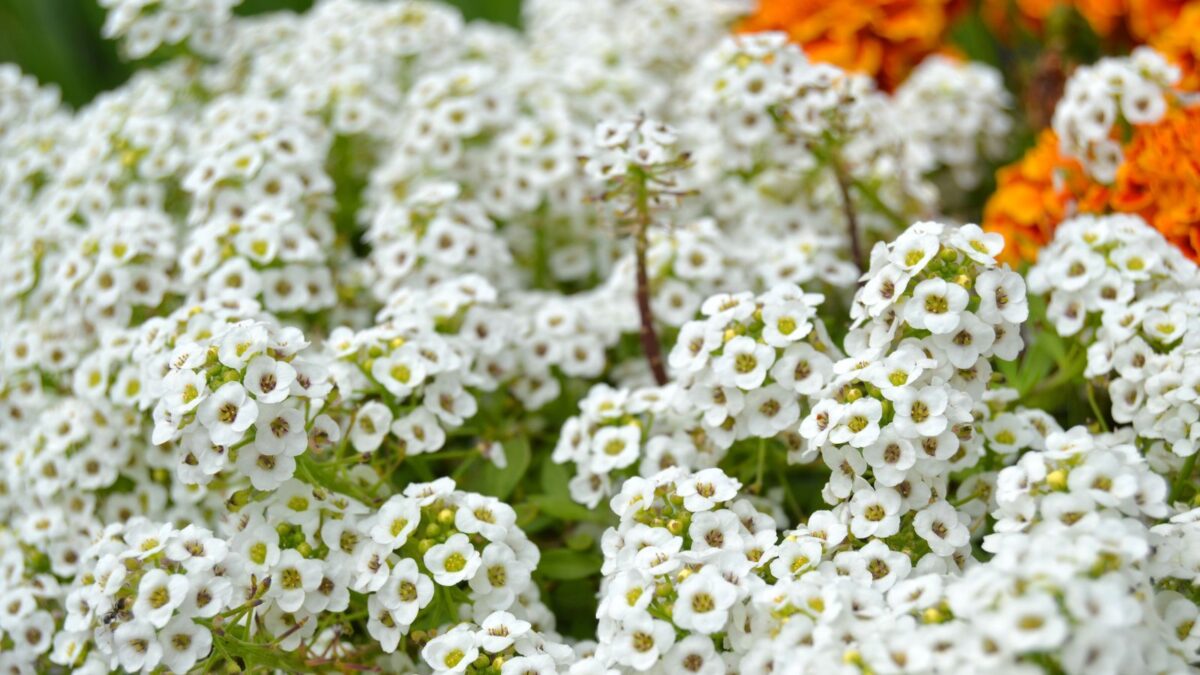While the most vibrantly colored flowers often attract our attention, there’s something to be said for the simple beauty of a plain white blossom. On their own, white flowers have an air of elegance, and they pair perfectly with any color. Annual white flowers have the added benefits of long bloom times and instant beauty.

1. White spider flower (Cleome houtteana)

An unusually tall annual at three to six feet, white spider flower is perfectly suited to back borders. Its airy flower clusters are also unique, with long, spindly stamens, and attract butterflies and hummingbirds. It often self-sows, though not invasively.
White spider flower prefers moist, well-drained soil in full sun, though it will tolerate some light shade or drought.
2. Sweet alyssum (Lobularia maritima)

A popular edging and filler plant, sweet alyssum produces masses of tiny white flowers that fill the air with sweet fragrance throughout the spring and fall. It often stops flowering in the heat of summer, but if left in place over winter, it will reseed and come up again in spring.
Sweet alyssum requires excellent soil drainage with medium moisture and full sun to part shade.
3. Cosmos (Cosmos bipinnatus)

In addition to a wide range of other colors, cosmos also come in pure white or bicolor options. Their papery petals surround a button-like yellow center and wave on tall stems above lovely ferny foliage. They readily self-seed, making them an excellent choice for a cottage garden.
Cosmos grow best with at least a half day of direct sunlight and in soil with good drainage.
4. Moonflower (Ipomoea alba)

Moonflower gets its name from its large, brilliantly white, trumpet-shaped flowers that open at night. These fragrant blossoms attract the unique hummingbird moths and sphinx moths. A climbing vine, moonflower can reach 15 feet long. It has large, heart-shaped leaves that provide beauty during the day.
Moonflower likes moist, well-drained soil in full sun. A tender perennial in USDA hardiness zones 10-12, it can be grown as an annual or planted in a container to bring inside over winter in cooler regions.
5. Sweet pea (Lathyrus odoratus)

Another wonderfully fragrant flower, annual sweet pea produces lovely two-lipped blossoms that bloom in elongated clusters from late spring into midsummer. This short twining vine grows just four to six feet long. Though closely resembling edible peas, sweet pea is poisonous.
Sweet pea likes rich, moist, well-drained soil in full sun to part shade, and especially appreciates afternoon shade in hot weather. It can become weedy in some areas, so take care not to let it spread.
6. Cyclamen (Cyclamen persicum)

Cyclamen forms a low mound of lovely little heart-shaped leaves, often dark green with a silvery pattern. The fragrant, solitary flowers form on long, slender stalks and look somewhat like butterflies. They bloom in spring and again in fall, going dormant during the heat of the summer.
Though winter hardy in zones 9-11, cyclamen is grown as an annual elsewhere. It prefers part shade and rich soil with good drainage.
7. Petunia (Petunia x hybrida)

The classic petunia comes in a range of colors, including brilliant white. Its showy, trumpet-shaped flowers bloom all summer long, especially when deadheaded. These sprawling bedding plants work well in hanging baskets and other containers as well as massed in beds or borders.
Petunias are wonderfully easy to grow. They thrive in moist, well-drained soil in full sun to part shade.
Here’s what to plant with petunias.
8. Euphorbia (Euphorbia hypericifolia)
A shrubby, spreading to erect herb, euphorbia grows up to two feet tall and blooms all season long with no deadheading needed. It produces clusters of tiny, insignificant flowers surrounded by showy white bracts for a lovely frosted appearance.
Native to the tropical Americas, euphorbia overwinters in zones 10-11 and may be cut back and placed in a sunny window indoors to overwinter in cooler regions. Otherwise, it is typically grown as an annual. This drought-tolerant plant likes well-drained soil in full to part sun.
9. Floss flower (Ageratum houstonianum)

Floss flower produces beautiful fluffy clusters of little aster-like flowers, with taller varieties making good cut flowers. Its low, clumping mounds of foliage are equally suited to containers and flower beds, and like many annuals, it blooms from spring until frost.
This dependable annual tolerates drought and part shade but appreciates moist, rich soil with good drainage in full sun.
10. False Queen Anne’s lace (Ammi majus)

True to its name, false Queen Anne’s lace blooms with flat, lacey umbels of tiny white flowers. These lovely blooms are held on long stems, reaching heights of three to six feet, above equally delicate finely divided foliage for a wonderfully elegant display.
False Queen Anne’s lace is most easily grown from seed, and it prefers full sun and moist soil with good drainage.
Red Perennial Flowers Create a Nice Contrast With the White Annuals

Red flowers look amazing against a mass of white blooms. Here’s a list of red perennial flowers you can add white annals to for a beautiful contrast.
Add Some Annual Blue Flowers for a Calming Effect

If a calming, relaxing atmosphere is what you’re looking for, plant one or more of these annual blue flowers for a stunning display of col and calm.



